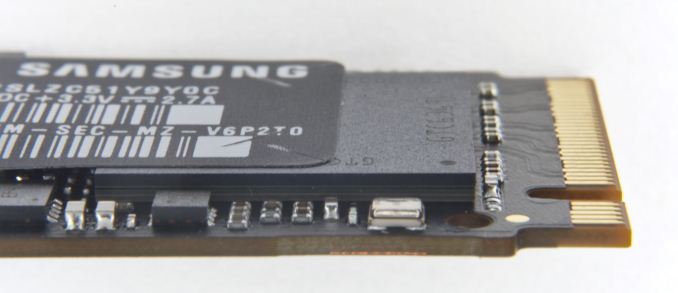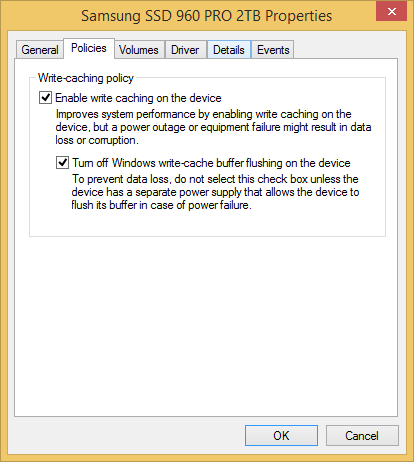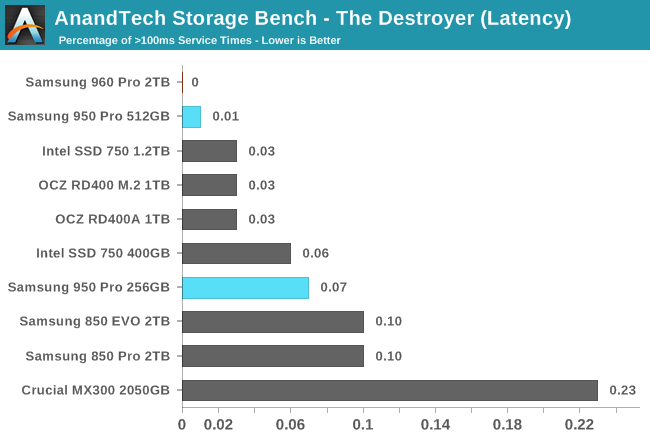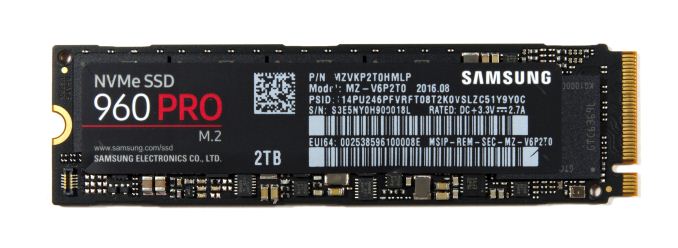
Original Link: https://www.anandtech.com/show/10754/samsung-960-pro-ssd-review
The Samsung 960 Pro (2TB) SSD Review
by Billy Tallis on October 18, 2016 10:00 AM EST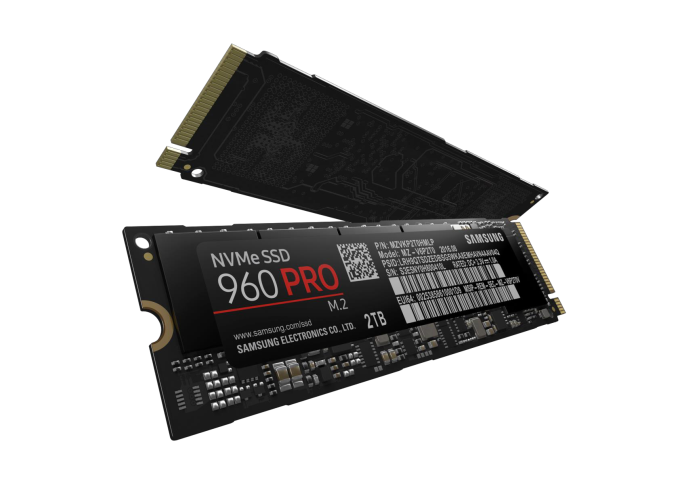
A year ago, Samsung brought their PCIe SSD technology to the retail market in the form of the Samsung 950 Pro, an NVMe M.2 SSD with Samsung's 3D V-NAND flash memory. The 950 Pro didn't appear out of nowhere—Samsung had shipped two generations of M.2 PCIe SSDs to OEMs, but before the 950 Pro they hadn't targeted consumers directly.
Now, the successor to the 950 Pro is about to hit the market. The Samsung 960 Pro is from one perspective just a generational refresh of the 950 Pro: the 32-layer V-NAND is replaced with 48-layer V-NAND that has twice the capacity per die, and the UBX SSD controller is replaced by its Polaris successor that debuted earlier this year in the SM961 and PM961 OEM SSDs. However...
| Samsung 960 PRO Specifications Comparison | ||||||
| 960 PRO 2TB | 960 PRO 1TB | 960 PRO 512GB | 950 PRO 512GB |
950 PRO 256GB |
||
| Form Factor | Single-sided M.2 2280 | Single-sided M.2 2280 | ||||
| Controller | Samsung Polaris | Samsung UBX | ||||
| Interface | PCIe 3.0 x4 | PCIe 3.0 x4 | ||||
| NAND | Samsung 48-layer 256Gb MLC V-NAND | Samsung 32-layer 128Gbit MLC V-NAND | ||||
| Sequential Read | 3500 MB/s | 3500 MB/s | 3500 MB/s | 2500MB/s | 2200MB/s | |
| Sequential Write | 2100 MB/s | 2100 MB/s | 2100 MB/s | 1500MB/s | 900MB/s | |
| 4kB Random Read (QD1) | 14k IOPS | 12k IOPS | 11k IOPS | |||
| 4kB Random Write (QD1) | 50k IOPS | 43k IOPS | 43k IOPS | |||
| 4kB Random Read (QD32) | 440k IOPS | 440k IOPS | 330k IOPS | 300k IOPS | 270k IOPS | |
| 4kB Random Write (QD32) | 360k IOPS | 360k IOPS | 330k IOPS | 110k IOPS | 85k IOPS | |
| Read Power | 5.8W | 5.3W | 5.1W | 5.7W (average) | 5.1W (average) | |
| Write Power | 5.0W | 5.2W | 4.7W | |||
| Endurance | 1200TB | 800TB | 400TB | 400TB | 200TB | |
| Warranty | 5 Year | 5 Year | ||||
| Launch MSRP | $1299 | $629 | $329 | $350 | $200 | |
... looking at the performance specifications of the 960 Pro, it clearly is much more than just a refresh. Part of this is due to the fact that PCIe SSDs simply have more room to advance than SATA SSDs, so it's possible for Samsung to add 1GB/s to the sequential read speed and to triple the random write speed. But to bring about those improvements and stay at the top of a market segment that is seeing new competition every month, Samsung has had to make significant changes to almost every aspect of the hardware.
We've already analyzed Samsung's 48-layer V-NAND in reviewing the 4TB 850 EVO it first premiered in. The Samsung 960 Pro uses the 256Gb MLC variant, which allows for a single 16-die package to contain 512GB of NAND, twice what was possible for the 950 Pro. Samsung has managed another doubling of drive capacity by squeezing four NAND packages on to a single side of the M.2 2280 card. Doing this while keeping to that single-sided design required freeing up the space taken by the DRAM, which is now stacked on top of the controller in a package-on-package configuration.
Samsung's Polaris controller is also a major change from the UBX controller used in the 950 Pro. Meeting the much higher performance targets of the 960 Pro with the UBX controller architecture would have required significantly higher clock speeds that the drive's power budget wouldn't allow for. Instead, the Polaris controller widens from three ARM cores to five, and now dedicates one core for communication with the host system.
The small size of the M.2 form factor combined with the higher power required to perform at the level expected of a PCIe 3.0 x4 SSD means that heat is a serious concern for M.2 PCIe SSDs. In general, these SSDs can be forced to throttle themselves rather than overheat when subjected by intensive benchmarks and stress tests, but at the same time most drives avoid thermal throttling during typical real-world use. Most heavy workloads are bursty, especially at 2GB/sec.
Even so, many users would prefer the benefits of reliable sustained performance offered by a well-cooled PCIe SSD, and almost every M.2 PCIe SSD is now doing something to address thermal concerns. Toshiba's OCZ RD400 is available with an optional PCIe x4 to M.2 add-in card that puts a thermal pad directly behind the SSD controller. Silicon Motion's SM2260 controller integrates a thin copper heatspreader on the top of the controller package. Plextor's M8Pe is available with a whole-drive heatspreader. Samsung has decided to put a few layers of copper into the label stuck on the back side of the 960 Pro. This is thin enough to not have any impact on the drive's mechanical compatibility with systems that require a single-sided drive, but the heatspreader-label does make a significant improvement in the thermal behavior of the 960 Pro, according to Samsung.
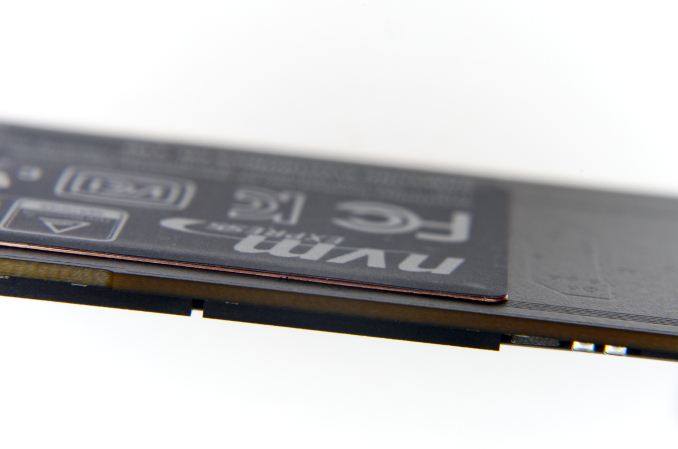 (click for full resolution close-up)
(click for full resolution close-up)
The warranty on the 960 Pro is five years, the same as for the 950 Pro but half of what is offered with the 850 Pro. When the 950 Pro was introduced, Samsung explained that the decreased warranty period on a higher-end product was due to NVMe and PCIe SSDs being a less mature technology than SATA SSDs. Despite having a very successful year with the 950 Pro, Samsung isn't bumping the warranty period back up to 10 years, and I would be surprised if they ever release a consumer SSD with such a long warranty period again.
Going hand in hand with the warranty period is the write endurance rating. The 512GB and 1TB models have endurance ratings that are equivalent to the drive writes per day offered by the 950 Pro. The 2TB 960 Pro's endurance rating falls short at 1200TB instead of the 1600TB that would be double the rating on the 1TB 960 Pro. When asked about this discrepancy during the Q&A session at Samsung's SSD Global Summit where the 960 Pro was announced, Samsung dodged the question and did not offer a satisfactory explanation.
The one other area where the 960 Pro does not promise significant progress is price. Despite switching to denser NAND, the MSRP of the 512GB 960 Pro is only slightly lower than the MSRP the 512GB 950 Pro launched with, and slightly higher than the current retail price of the 950 Pro. The 960 Pro is using more advanced packaging for the controller and NAND and the controller itself likely costs a bit more, but the bigger factor keeping the price up is probably the dearth of serious competition.
When the Samsung 950 Pro launched, its main competition in the PCIe space was the Intel SSD 750, a derivative of their enterprise PCIe SSD line equipped with consumer-oriented firmware. It's big and power hungry, but brought NVMe to the consumer market and set quite a few performance records in the process. The 950 Pro couldn't beat the SSD 750 in every test, but it comes out ahead where it matters most for everyday client workloads. Since then, new NVMe controllers have arrived from Marvell, Silicon Motion and Phison. We reviewed the OCZ RD400 and found it was able to beat the 950 Pro in several tests, especially when considering the 1TB RD400 against the largest 950 Pro that is only 512GB. We will be comparing the 2TB Samsung 960 Pro against its predecessor and these competing high-end PCIe SSDs, as well as three 2TB-class SATA SSDs.
| AnandTech 2015 SSD Test System | |
| CPU | Intel Core i7-4770K running at 3.5GHz (Turbo & EIST enabled, C-states disabled) |
| Motherboard | ASUS Z97 Pro (BIOS 2701) |
| Chipset | Intel Z97 |
| Memory | Corsair Vengeance DDR3-1866 2x8GB (9-10-9-27 2T) |
| Graphics | Intel HD Graphics 4600 |
| Desktop Resolution | 1920 x 1200 |
| OS | Windows 8.1 x64 |
- Thanks to Intel for the Core i7-4770K CPU
- Thanks to ASUS for the Z97 Deluxe motherboard
- Thanks to Corsair for the Vengeance 16GB DDR3-1866 DRAM kit, RM750 power supply, Carbide 200R case, and Hydro H60 CPU cooler
A Note About Drivers
The Intel SSD 750, the Samsung 950 Pro and the OCZ RD400 were all reviewed with the NVMe drivers supplied by the SSD vendors. In the past, vendors have sometimes cited performance as an advantage to using their NVMe driver over the one built in to Windows, but the primary reason has been that Microsoft's driver implements a limited feature set. The driver that was made available as an update to add NVMe support to Windows 7 SP1 and Windows Server 2008 SP1 did not include the necessary interfaces for updating SSD firmware, and even on Windows 8.1 and later the vendor-specific management tools require their own driver for performing tasks like a secure erase.
Samsung's NVMe driver for the 960 Pro was not ready in time for this review. They are planning to release it in mid-November in conjunction with their Magician 5.0 utility. The Samsung NVMe driver will be required to support Magician 5.0's new "Magic Vault" secure archive/backup feature and the new secure file erase feature.
In the meantime, rather than try to hack Samsung's NVMe driver for the 950 Pro to work with the 960 Pro, this review is relying on Microsoft's NVMe driver built-in to Windows 8.1. While most SSD vendors (especially the smaller ones) now say that Microsoft's NVMe driver offers adequate performance and that there is no need for a custom driver to get full performance, there are some pitfalls.
Windows provides two settings for drive write caching policy. By default, write caching is enabled on internal drives and there is an unselected option to turn off write cache buffer flushing. Both options have warnings attached about the possibility of data loss in the event of a power failure. It is normal for SSDs to cache and combine writes rather than immediately send all written data straight to the flash, and this is necessary to overcome the fact that NAND flash write operations are inherently much slower than read operations. Without write caching on the SSD, we would never see good random write performance, let alone random write performance that exceeds random read performance.
The default write caching policy settings work fine for SATA SSDs. This is not the case for NVMe SSDs when using Microsoft's driver. Microsoft's NVMe driver in the default configuration is extremely conservative about write caching, leading to extremely poor performance on some tests. Checking the second box gives performance that is as expected while leaving it unchecked for a high-end NVMe drive can lead to worse performance than a low-end SATA drive. Normally I would not review a drive with an obscure setting like this changed, especially since it can increase the risk of data loss, but Microsoft's default is clearly broken and not in line with the industry standard practices. The 960 Pro was benchmarked with the settings as shown above, and a more thorough comparison of how NVMe drivers and operating system versions affect performance will be coming in the future.
Performance Consistency
Our performance consistency test explores the extent to which a drive can reliably sustain performance during a long-duration random write test. Specifications for consumer drives typically list peak performance numbers only attainable in ideal conditions. The performance in a worst-case scenario can be drastically different as over the course of a long test drives can run out of spare area, have to start performing garbage collection, and sometimes even reach power or thermal limits.
In addition to an overall decline in performance, a long test can show patterns in how performance varies on shorter timescales. Some drives will exhibit very little variance in performance from second to second, while others will show massive drops in performance during each garbage collection cycle but otherwise maintain good performance, and others show constantly wide variance. If a drive periodically slows to hard drive levels of performance, it may feel slow to use even if its overall average performance is very high.
To maximally stress the drive's controller and force it to perform garbage collection and wear leveling, this test conducts 4kB random writes with a queue depth of 32. The drive is filled before the start of the test, and the test duration is one hour. Any spare area will be exhausted early in the test and by the end of the hour even the largest drives with the most overprovisioning will have reached a steady state. We use the last 400 seconds of the test to score the drive both on steady-state average writes per second and on its performance divided by the standard deviation.
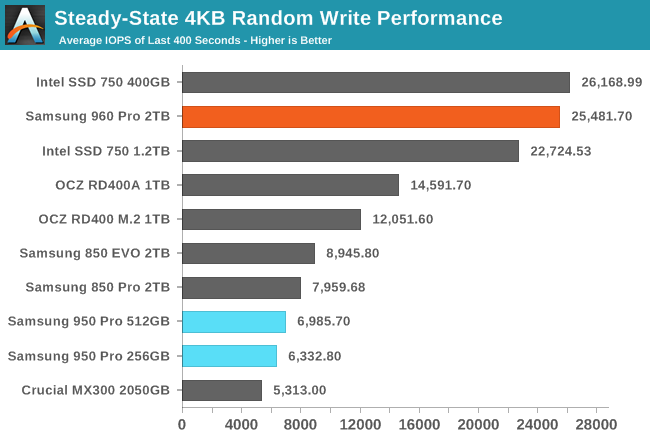
The enterprise SSD heritage of the Intel SSD 750 continues to shine through as it holds on to the lead for steady-state random write performance, but Samsung has mostly caught up with the 960 Pro. This is a huge change from the 950 Pro, which had steady-state performance that was no better than typical SATA SSDs. A few consumer SSDs have offered great steady-state random write performance—most notably OCZ's drives based on the Indilinx Barefoot 3 controller—but the 960 Pro is the first one to reach the level of the Intel SSD 750.
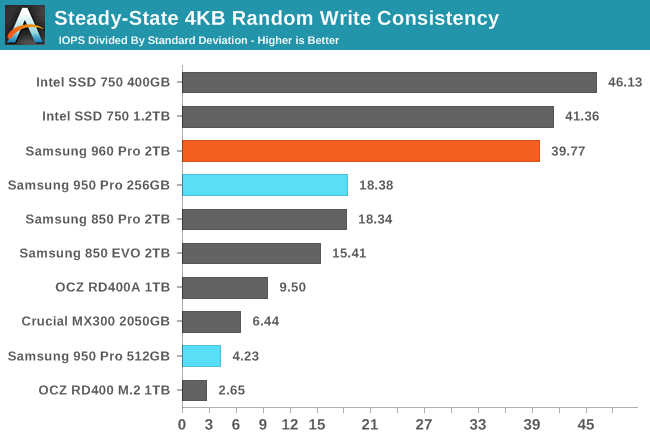
In addition to mostly closing the performance gap, the 960 Pro has a great consistency score that is almost as good as the Intel SSD 750's score. While OCZ's Vector 180 offered remarkably high average performance in its steady state, it was far less consistent than the either the Samsung 960 Pro or the Intel SSD 750 and instead the standard deviation of its steady state performance was more than ten times greater.
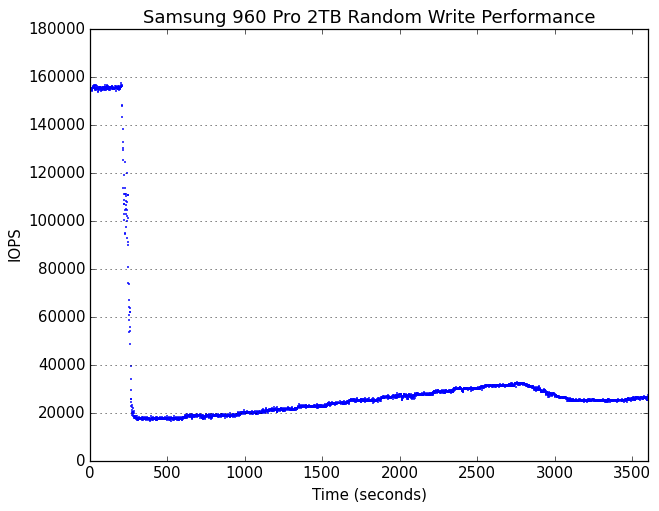 |
|||||||||
| Default | |||||||||
| 25% Over-Provisioning | |||||||||
After the initial period of very high performance, the 960 Pro enters a steady state with very good short-term consistency but gradual long-term variation in performance. This is more similar in character to the behavior of the Intel SSD 750 than Samsung's earlier SSDs, though it's interesting to note that the 960 Pro is more twice as fast during the initial phase before transitioning to steady state.
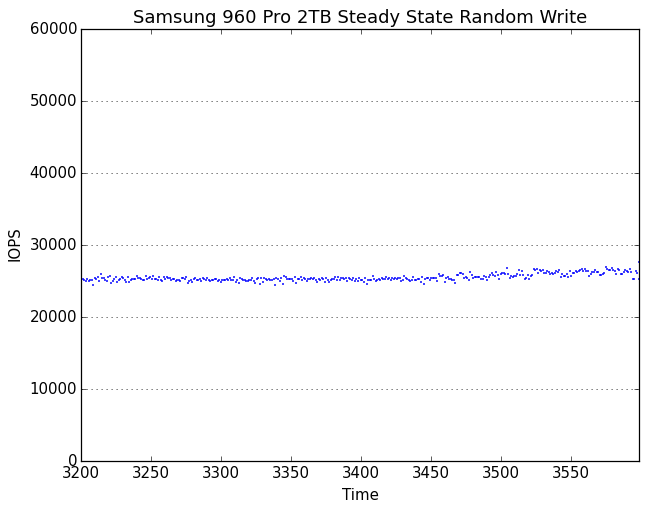 |
|||||||||
| Default | |||||||||
| 25% Over-Provisioning | |||||||||
Focusing on the last 400 seconds of the test shows the 960 Pro's steady state to be essentially flawless, rounding out a full page of what can be considered to be perfect scores for a consumer drive. The performance would even make the 960 Pro a pretty good enterprise SSD, and this is usually not the case for drives with consumer-oriented firmware.
AnandTech Storage Bench - The Destroyer
The Destroyer is an extremely long test replicating the access patterns of very IO-intensive desktop usage. A detailed breakdown can be found in this article. Like real-world usage and unlike our Iometer tests, the drives do get the occasional break that allows for some background garbage collection and flushing caches, but those idle times are limited to 25ms so that it doesn't take all week to run the test.
We quantify performance on this test by reporting the drive's average data throughput, a few data points about its latency, and the total energy used by the drive over the course of the test.
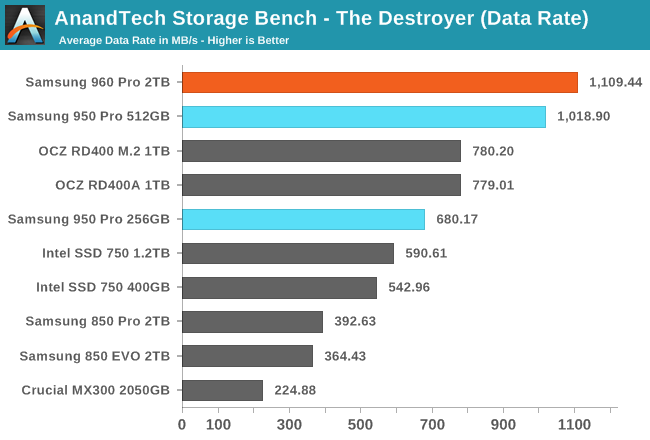
The 2TB 960 Pro sets a new record with a higher average data rate than the 950 Pro, but the improvement isn't huge, especially given the large increase in capacity over the 512GB 950 Pro.
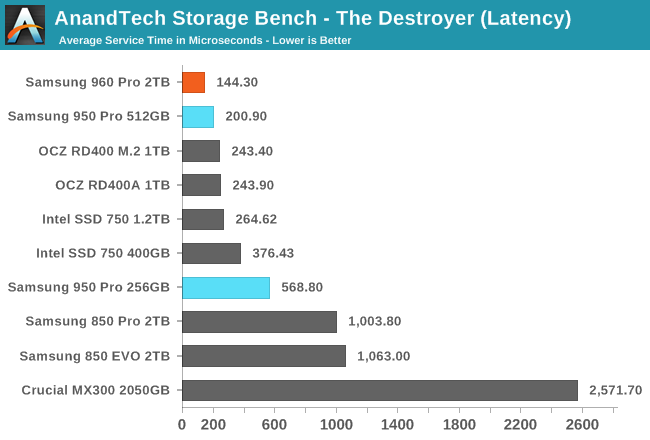
The 2TB 960 Pro reduces the average service time by almost 30% compared to the next fastest drive. SATA SSDs can't deliver average service times this low even on the ATSB Light test.
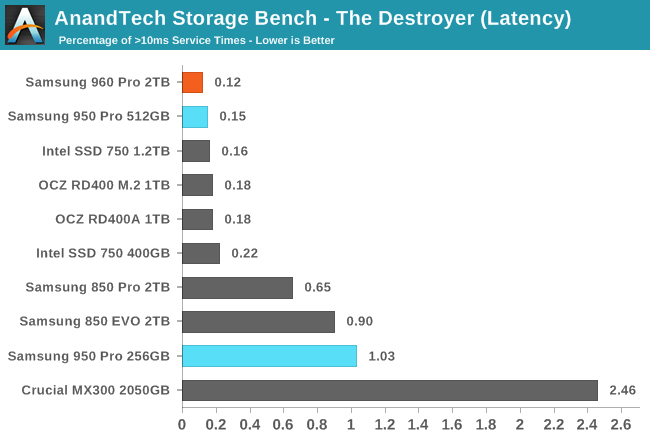
For the first time, a drive has completed The Destroyer without any operations taking more than 100ms. Though at a tighter standard of 10ms, the improvement from the 950 Pro is relatively small.
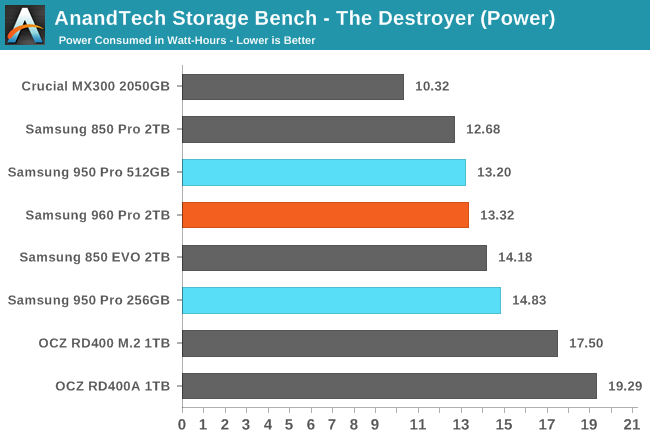
Essentially no power efficiency was sacrificed for the increased performance of the 960 Pro over its predecessors, though some SATA drives are more efficient.
AnandTech Storage Bench - Heavy
Our Heavy storage benchmark is proportionally more write-heavy than The Destroyer, but much shorter overall. The total writes in the Heavy test aren't enough to fill the drive, so performance never drops down to steady state. This test is far more representative of a power user's day to day usage, and is heavily influenced by the drive's peak performance. The Heavy workload test details can be found here.
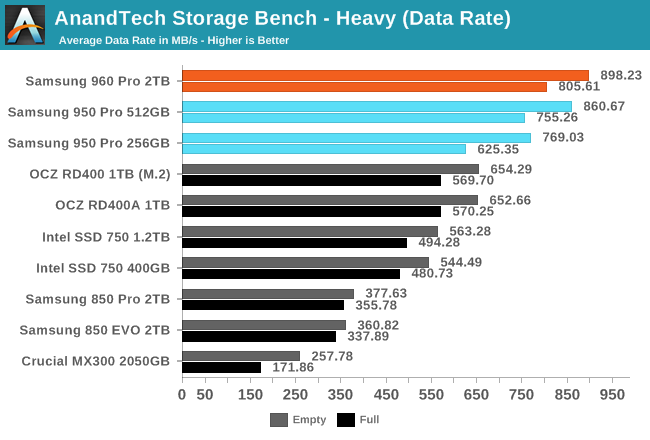
The Samsung 950 Pro was still unmatched in average data rate, even against higher capacity competition. The 2TB 960 Pro pushes the limits a little further.
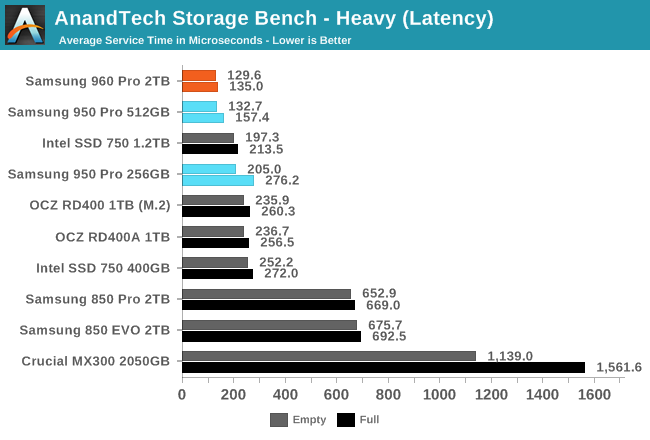
The 2TB 960 Pro delivers a slightly lower average service time than the 512GB 950 Pro, and the other PCIe SSDs are well behind.
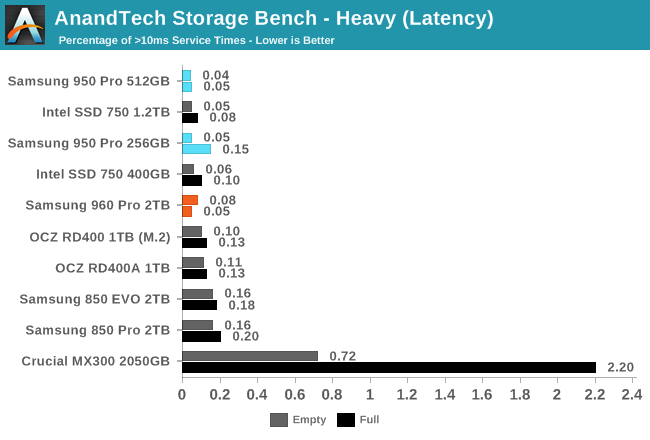
Samsung's PCIe SSDs and the Intel 750 are all very close in terms of the number of high-latency outliers they experience, while the other PCIe SSDs and the best SATA SSDs are 2-4x worse.
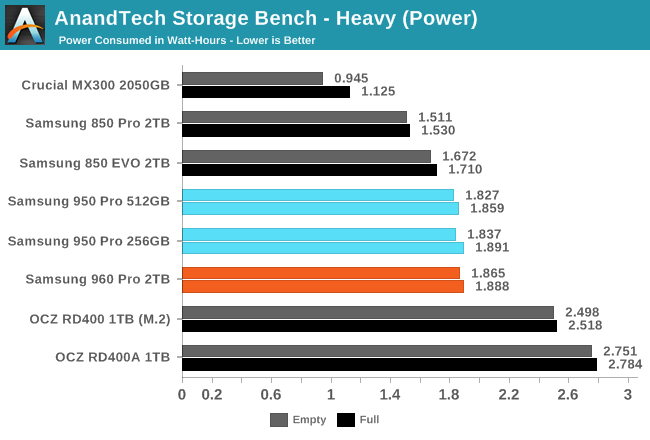
The 960 Pro's power consumption is almost identical to the 950 Pro. Samsung's PCIe SSDs have a clear lead over other PCIe SSDs but are not as efficient as the SATA drives.
AnandTech Storage Bench - Light
Our Light storage test has relatively more sequential accesses and lower queue depths than The Destroyer or the Heavy test, and it's by far the shortest test overall. It's based largely on applications that aren't highly dependent on storage performance, so this is a test more of application launch times and file load times. This test can be seen as the sum of all the little delays in daily usage, but with the idle times trimmed to 25ms it takes less than half an hour to run. Details of the Light test can be found here.
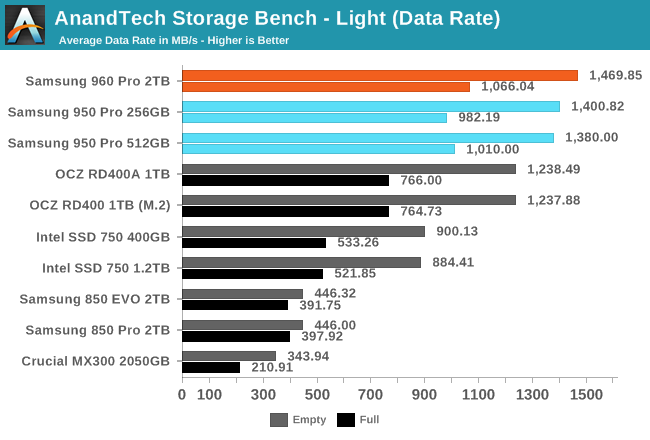
Once again, Samsung breaks its own unchallenged record with average data rates on the Light test. The NVMe drives all show a relatively large disparity in performance when the test is run on a full drive compared to starting on an empty drive, while the faster SATA drives have very little room to perform better on an empty drive.
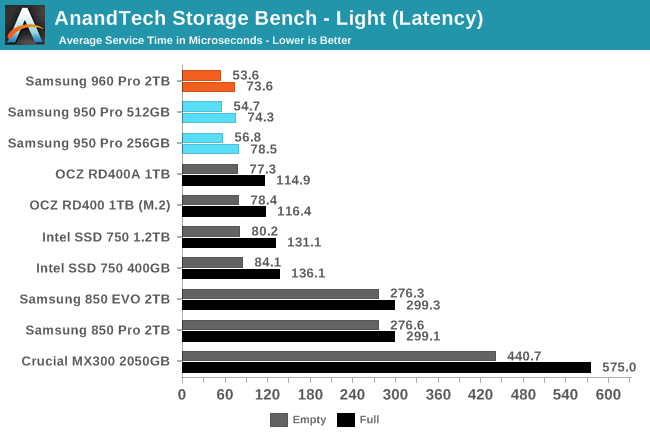
The 960 Pro shows almost no improvement in average service time, but it doesn't need to since its worst-case full drive performance is better than the competition's best case.
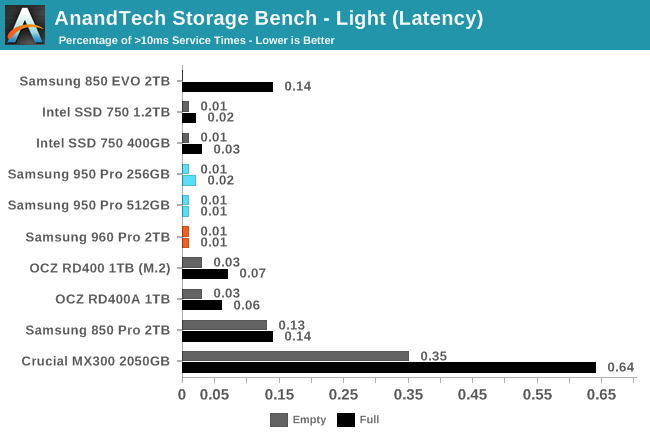
Of the PCIe SSDs only the OCZ RD400 experiences more than a handful of operations that take longer than 10ms to complete. The Samsung 850 EVO is itself an odd outlier because the Light test fits entirely within its SLC cache, so no operations take more than 10ms.
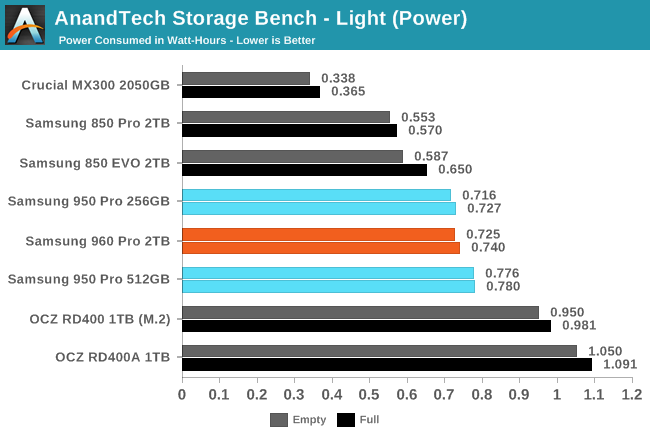
The 960 Pro's power efficiency is once again similar to the 950 Pro: better than the other PCIe SSDs but not as good as a decent SATA SSD.
Random Read Performance
The random read test requests 4kB blocks and tests queue depths ranging from 1 to 32. The queue depth is doubled every three minutes, for a total test duration of 18 minutes. The test spans the entire drive, which is filled before the test starts. The primary score we report is an average of performances at queue depths 1, 2 and 4, as client usage typically consists mostly of low queue depth operations.

The Samsung 960 Pro slightly widens what was already a commanding lead in low queue depth random read performance.
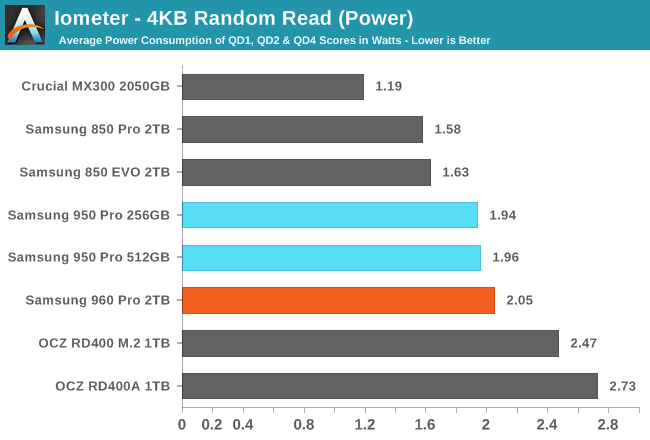
The 960 Pro's power usage is higher in proportion to its increased performance. Only a handful of the smallest and lowest-power SATA SSDs are more efficient, but at half the overall performance.
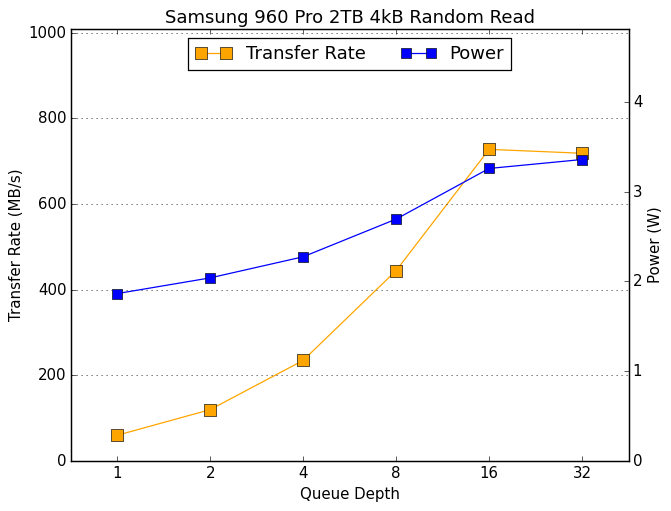 |
|||||||||
While they are unmatched at lower queue depths, both the 960 Pro and the 950 Pro under-perform expectations at QD32. This hardly matters for a consumer SSD.
Random Write Performance
The random write test writes 4kB blocks and tests queue depths ranging from 1 to 32. The queue depth is doubled every three minutes, for a total test duration of 18 minutes. The test is limited to a 16GB portion of the drive, and the drive is empty save for the 16GB test file. The primary score we report is an average of performances at queue depths 1, 2 and 4, as client usage typically consists mostly of low queue depth operations.
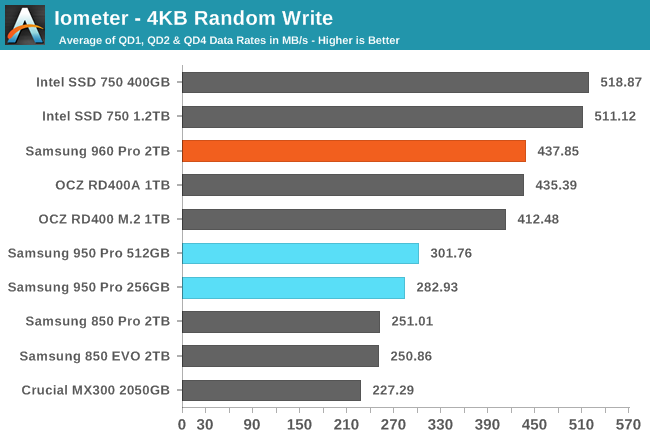
The 960 Pro's random write performance is a big improvement over the 950 Pro, catching up with the OCZ RD400 but still well behind the Intel 750.
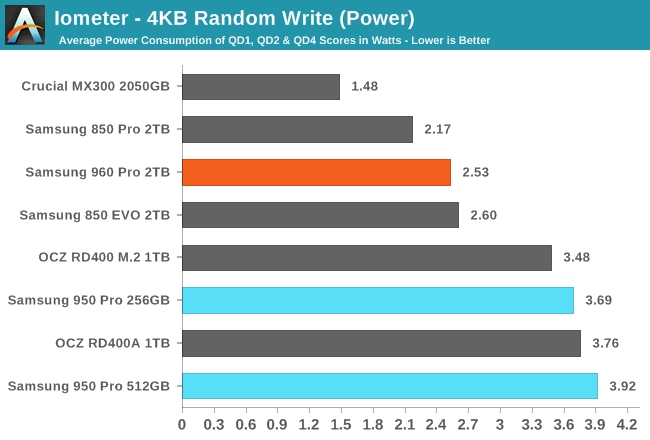
In addition to greatly improving random write performance over the 950 Pro, the 960 Pro greatly improves power consumption and jumps to the top of the efficiency ranking, just ahead of the Crucial MX300.
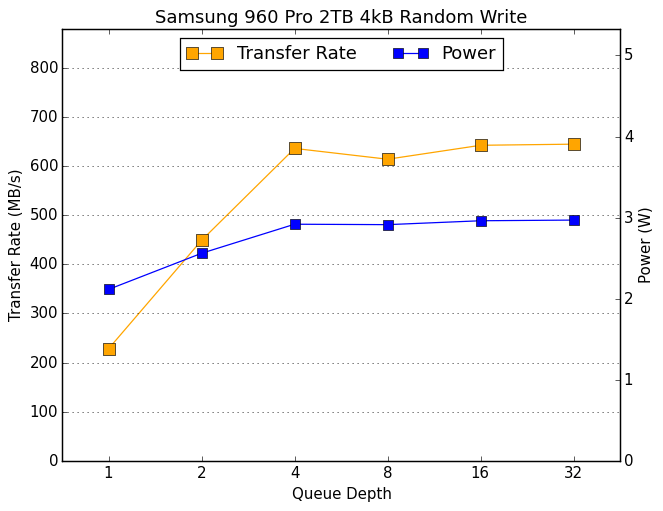 |
|||||||||
Where thermal throttling prevented the 950 Pro from improving past QD2, the 960 Pro scales up to QD4 and plateaus at that level for the second half of the test, with somewhat steadier performance than the OCZ RD400 that draws more power and thus has more thermal throttling to contend with. The Intel 750 with its massive heatsink entirely avoids thermal throttling.
Sequential Read Performance
The sequential read test requests 128kB blocks and tests queue depths ranging from 1 to 32. The queue depth is doubled every three minutes, for a total test duration of 18 minutes. The test spans the entire drive, and the drive is filled before the test begins. The primary score we report is an average of performances at queue depths 1, 2 and 4, as client usage typically consists mostly of low queue depth operations.
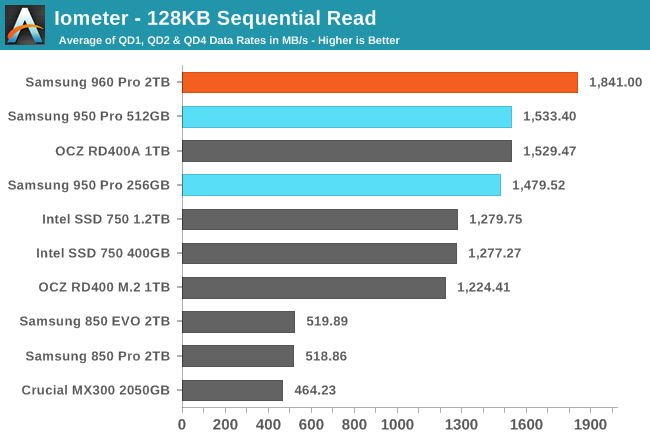
The 2TB 960 Pro's low queue depth sequential read speed is about 300MB/s faster than the 950 Pro, once again giving Samsung the clear lead in performance and showing that the 960 Pro is significantly better than the 950 Pro where thermal limits are a factor.
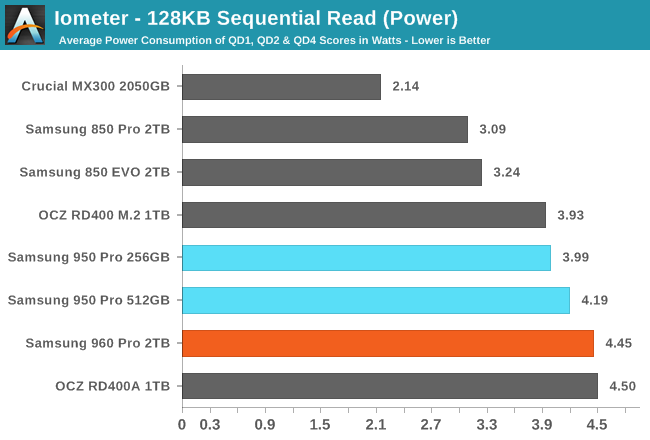
The 960 Pro consumes more power than its predecessors, but given the high performance it is the most efficient drive for this workload.
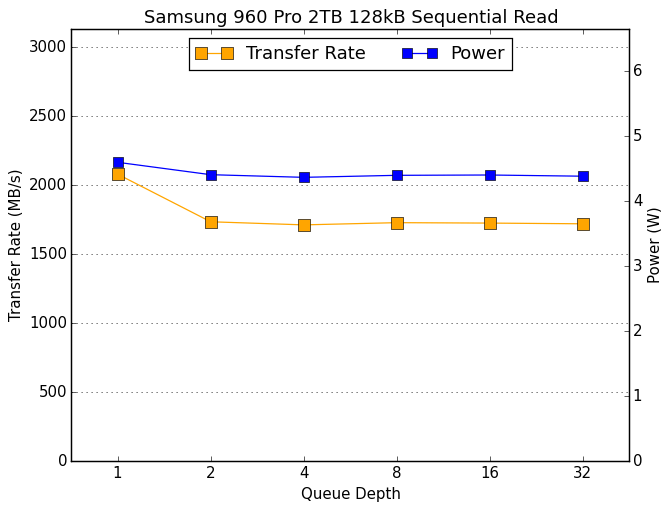 |
|||||||||
The slight drop in performance beyond QD1 indicates that the 960 Pro is still thermally limited for most of this test, and that like the 950 Pro it may perform much better with a heatsink.
Sequential Write Performance
The sequential write test writes 128kB blocks and tests queue depths ranging from 1 to 32. The queue depth is doubled every three minutes, for a total test duration of 18 minutes. The test spans the entire drive, and the drive is filled before the test begins. The primary score we report is an average of performances at queue depths 1, 2 and 4, as client usage typically consists mostly of low queue depth operations.
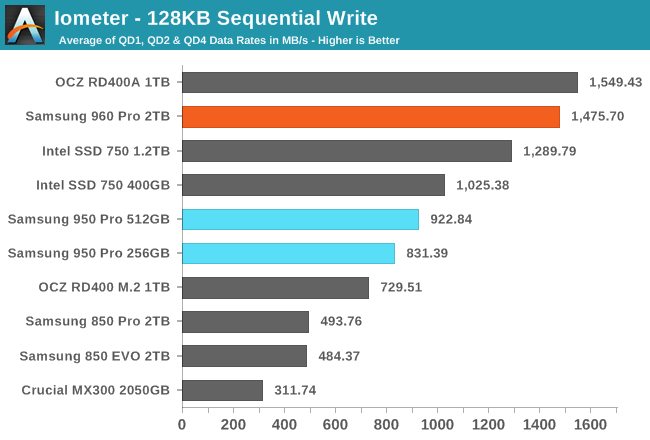
Thermals are an even bigger factor for the sequential write test than for sequential reads. The 960 Pro is 60% faster than the next fastest M.2 SSD and almost catches up to the RD400A with its thermal pad behind the controller allowing it to use its adapter card as a heatsink.
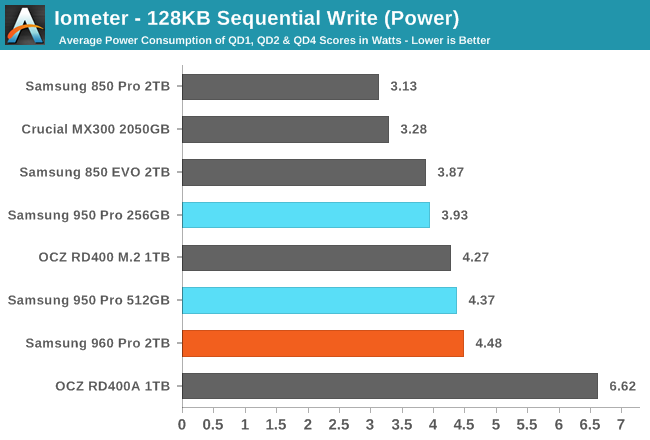
The 960 Pro's power consumption is only slightly higher than its M.2 competitors and far less than the RD400A. Given the performance, this makes the 960 Pro by far the most efficient SSD on this test, with about 30% higher performance per watt than the next most efficient drive.
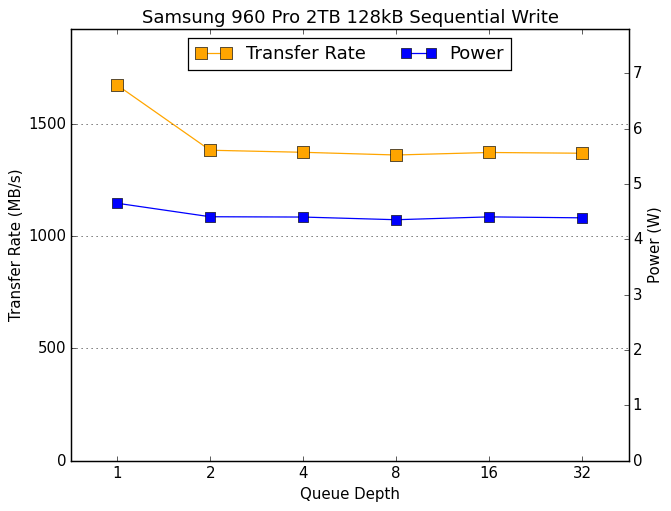 |
|||||||||
The QD1 performance of the 960 Pro is substantially higher than during the rest of the test where the drive is continuously thermally limited. The power consumption is only slightly higher at QD1 as the drive is able to spend a bit more power before its temperature gets up to the limit, then the drive reaches equilibrium at around 4.4W.
Mixed Random Read/Write Performance
The mixed random I/O benchmark starts with a pure read test and gradually increases the proportion of writes, finishing with pure writes. The queue depth is 3 for the entire test and each subtest lasts for 3 minutes, for a total test duration of 18 minutes. As with the pure random write test, this test is restricted to a 16GB span of the drive, which is empty save for the 16GB test file.
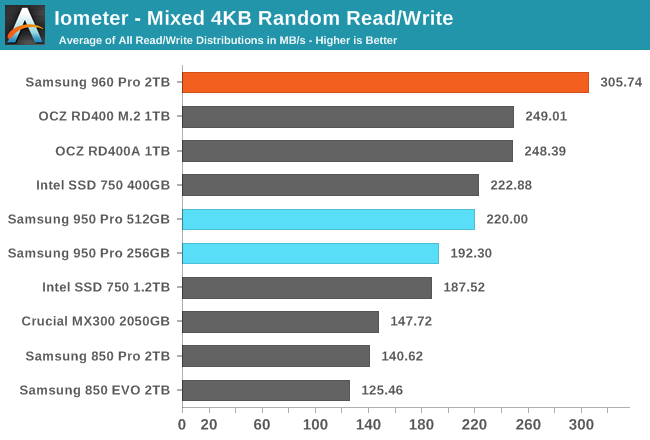
The Samsung 950 Pro never had a clear lead on the mixed random I/O test, and then the OCZ RD400 raised the bar. The 960 Pro is 22% faster than that and is alone at the top.
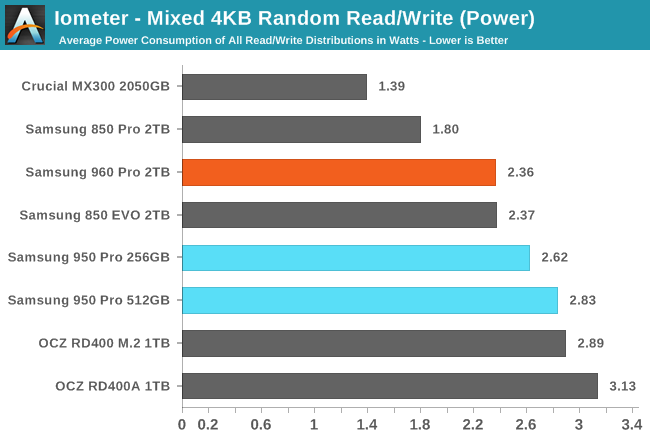
The 960 Pro has power draw comparable to the SATA SSDs that are less than half the speed, and clearly lower than the power draw of the other NVMe SSDs.
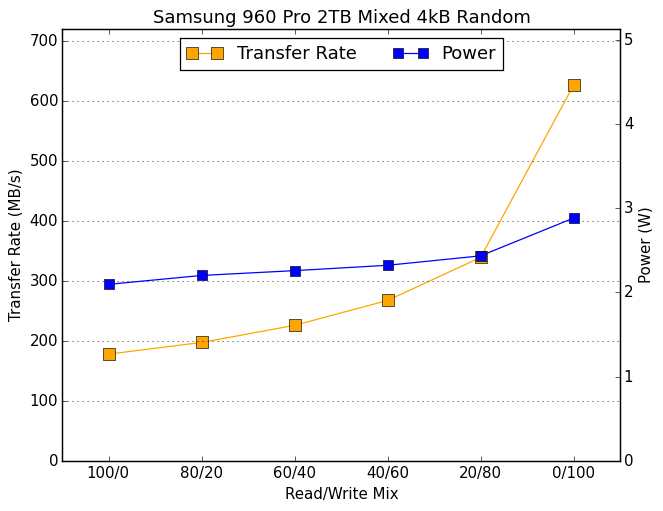 |
|||||||||
Most of these drives spend at least the first half of the test below 200MB/s and bring their score up with a strong finish of fast random writes. The 960 Pro hits 200MB/s in the second phase and continues increasing throughout the test, then finishes with a random write speed that beats even the Intel SSD 750.
Mixed Sequential Read/Write Performance
The mixed sequential access test covers the entire span of the drive and uses a queue depth of one. It starts with a pure read test and gradually increases the proportion of writes, finishing with pure writes. Each subtest lasts for 3 minutes, for a total test duration of 18 minutes. The drive is filled before the test starts.
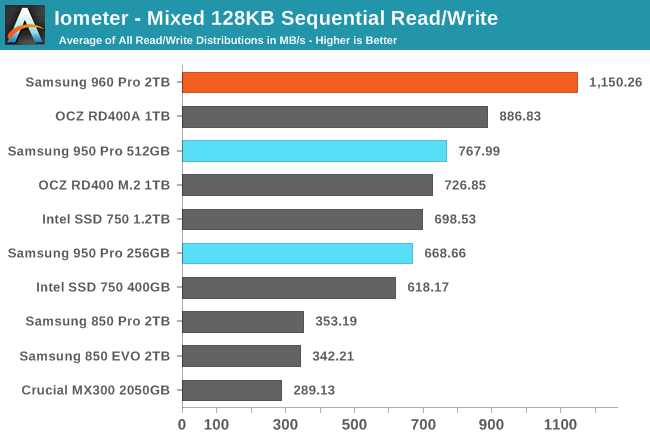
The 960 Pro's mixed sequential speeds are a big jump over any previous drive, with about a 30% advantage over the OCZ RD400A and over three times the performance of any SATA drive.
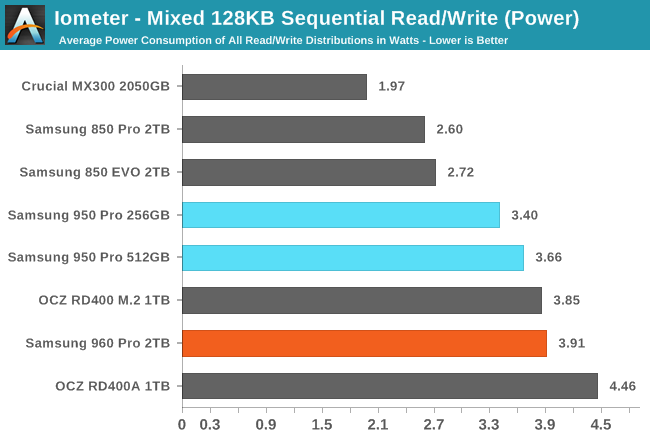
The 960 Pro's power consumption is about the same as the OCZ RD400 and slightly higher than the 950 Pro, so it is only about 15% more efficient than any other drive.
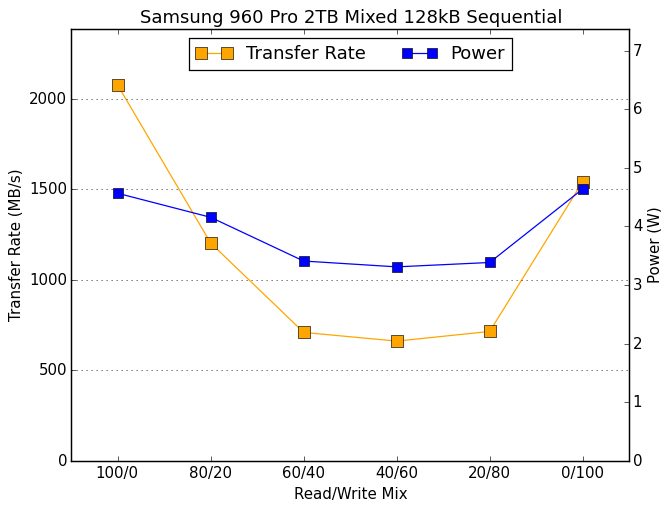 |
|||||||||
At the beginning and end of the test the 960 Pro appears to be thermally limited with power consumption above 4W. In the middle of the test where it is typical to see the lowest performance, the 960 Pro doesn't even come close to dropping down to SATA speeds. Its nearest competitor in performance (the OCZ RD400) has much worse performance during the early read-heavy parts of the test.
ATTO
ATTO's Disk Benchmark is a quick and easy freeware tool to measure drive performance across various transfer sizes.
 |
|||||||||
The 960 Pro hits full performance at 32kB or larger transfers, while the Intel SSD 750 doesn't reach its highest read speeds until 1MB transfers and the OCZ RD400 needs 512kB transfers for its highest read speeds. Unlike the 512GB 950 Pro, the 960 Pro does not hit any severe thermal throttling.
AS-SSD
AS-SSD is another quick and free benchmark tool. It uses incompressible data for all of its tests, making it an easy way to keep an eye on which drives are relying on transparent data compression. The short duration of the test makes it a decent indicator of peak drive performance.
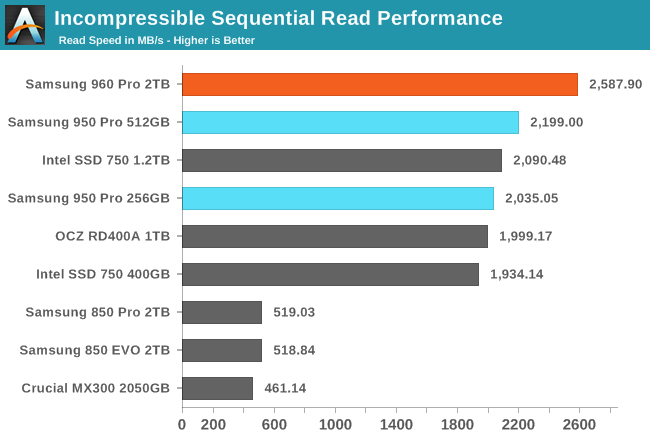
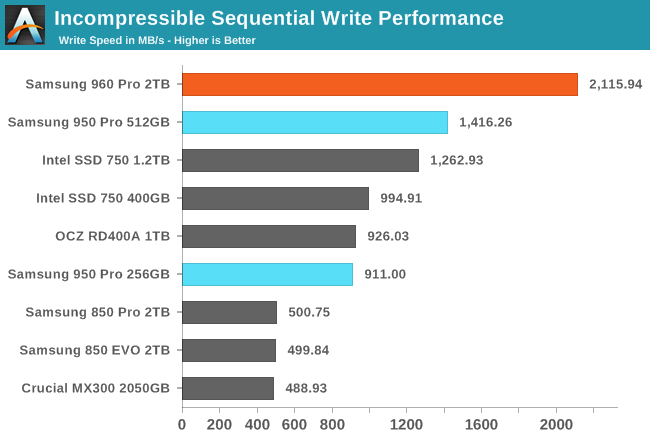
The 960 Pro's read speed breaks away from the pack of other PCIe SSDs but still doesn't come close to the advertised 3.5GB/s. The write speed stands out even more and very slightly exceeds the advertised speed of 2100MB/s.
Idle Power Consumption
Since the ATSB tests based on real-world usage cut idle times short to 25ms, their power consumption scores paint an inaccurate picture of the relative suitability of drives for mobile use. During real-world client use, a solid state drive will spend far more time idle than actively processing commands.
There are two main ways that a NVMe SSD can save power when idle. The first is through suspending the PCIe link through the Active State Power Management (ASPM) mechanism, analogous to the SATA Link Power Management mechanism. Both define two power saving modes: an intermediate power saving mode with strict wake-up latency requirements (eg. 10µs for SATA "Partial" state) and a deeper state with looser wake-up requirements (eg. 10ms for SATA "Slumber" state). SATA Link Power Management is supported by almost all SSDs and host systems, though it is commonly off by default for desktops. PCIe ASPM support on the other hand is a minefield and it is common to encounter devices that do not implement it or implement it incorrectly. Forcing PCIe ASPM on for a system that defaults to disabling it may lead to the system locking up; this is the case for our current SSD testbed and thus we are unable to measure the effect of PCIe ASPM on SSD idle power.
The NVMe standard also defines a drive power management mechanism that is separate from PCIe link power management. The SSD can define up to 32 different power states and inform the host of the time taken to enter and exit these states. Some of these power states can be operational states where the drive continues to perform I/O with a restricted power budget, while others are non-operational idle states. The host system can either directly set these power states, or it can declare rules for which power states the drive may autonomously transition to after being idle for different lengths of time.
The big caveat to NVMe power management is that while I am able to manually set power states under Linux using low-level tools, I have not yet seen any OS or NVMe driver automatically engage this power saving. Work is underway to add Autonomous Power State Transition (APST) support to the Linux NVMe driver, and it may be possible to configure Windows to use this capability with some SSDs and NVMe drivers. NVMe power management including APST fortunately does not depend on motherboard support the way PCIe ASPM does, so it should eventually reach the same widespread availability that SATA Link Power Management enjoys.
We report two idle power values for each drive: an active idle measurement taken with none of the above power management states engaged, and an idle power measurement with either SATA LPM Slumber state or the lowest-power NVMe non-operational power state, if supported.
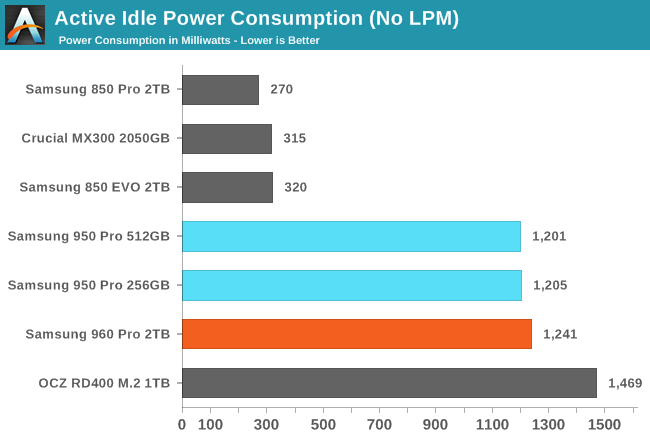
The active idle power consumption of the PCIe SSDs is still far higher than is typical for SATA SSDs, and is enough to keep their temperatures relatively high as well. The 960 Pro 2TB draws only slightly more power than the 950 Pro.
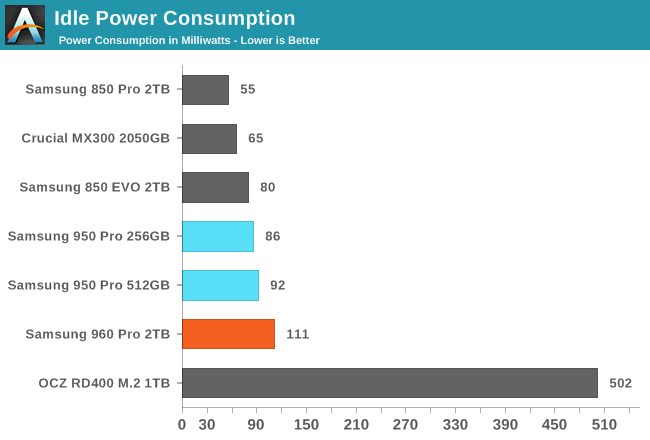
With power saving modes enabled, the Samsung NVMe SSDs are almost as efficient as typical SATA SSD, with the 960 Pro unsurprisingly drawing a little more power than the lower-capacity 950 Pros. The OCZ RD400 does benefit some from power management, but still draws far more than it should.
Final Words
In setting their lofty goals for the drive, the 2TB Samsung 960 Pro does not quite live up to every performance specification. But against any other standard it is a very fast drive. It increases performance over its predecessor across the board. It sets new performance records on almost every test while staying within roughly the same power and thermal limits, leading it to also set many new records for efficiency where previous PCIe SSDs have tended to sacrifice efficiency to reach higher performance.
The 960 Pro's performance even suggests that it may be a suitable enterprise SSD. While it lacks power loss protection capacitors that are still found on most enterprise SSDs (and are the reason why the longer M.2 22110 size is typically used for enterprise M.2 SSDs), the 960 Pro's performance on our random write consistency test is clearly enterprise-class and in the high-airflow environment of a server it should deliver much better sustained performance where it throttled due to high temperatures in our desktop testbed. Samsung probably won't have to change much other than the write endurance rating to make a good enterprise SSD based off this Polaris controller.
SATA SSDs are doing well to improve performance by a few percent, and power efficiency is for the most part also not improving much. PCIe 3.0 is not fully exploited by any current product, so generational improvements of NVMe SSDs can be much larger. In the SATA market gains this big would be revolutionary whether considered in terms of relative percentage improvement or absolute MB/s and IOPS gained.
On the other hand, this was a comparison of a 2TB drive against PCIe SSDs that were all much smaller; it has four times the capacity and twice the NAND die count of the largest and fastest 950 Pro. Higher capacity almost always enables higher performance, and it appears in many tests that the 512GB 960 Pro may not have much if any advantage over either its predecessor or the current fastest drive of similar capacity.
This review should not be taken as the final word on the Samsung 960 Pro. We still intend to test the smaller and more affordable capacities, and to conduct a more thorough investigation of its thermal throttling behavior. We also need to test against the Windows 10 NVMe driver and will test with any driver Samsung releases. Additionally, we look forward to testing the Samsung 960 EVO, which uses the same Polaris controller but TLC V-NAND with an SLC cache. The 960 EVO has a shorter warranty period and lower endurance rating, but still promises higher performance than the 950 Pro and at a much lower price.
The $1299 MSRP on the 2TB 960 Pro is almost as shocking as the $1499 MSRP for the 4TB 850 EVO was. This drive is not for everyone, though it might be coveted by everyone. But for those who have the money, the price per gigabyte is not outlandish. Aside from Intel's TLC-based SSD 600p, PCIe SSDs currently start around $0.50/GB, and at $0.63/GB the 960 Pro is more expensive than the Plextor M8Pe but cheaper than the Intel SSD 750 or the OCZ RD400A. Samsung is by no means price gouging and they could justify charging even more based on the performance and efficiency advantages the 960 Pro has over the competitors. The 960 Pro and 960 EVO are not yet listed on Amazon and are only listed as "Coming Soon" with no price on Newegg, but they can be pre-ordered direct from Samsung with an estimated ship time of 2-4 weeks.
The 960 Pro appears to not offer much cost savings over the 950 Pro despite the switch from 32-layer V-NAND to 48-layer V-NAND. The 48-layer V-NAND has had trouble living up to expectations and was much later to market than Samsung had planned for: the 950 Pro was initially supposed to switch over in the first half of this year and gain a 1TB capacity. This doesn't pose a serious concern for the 960 Pro, but it is clear that Samsung was too optimistic about the ease of scaling up 3D NAND and their projections for the 64-layer generation should be regarded with increased skepticism.

